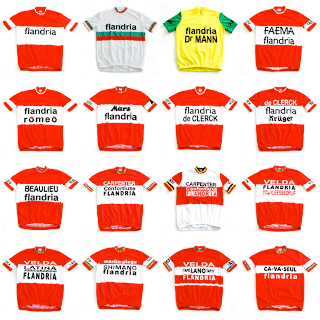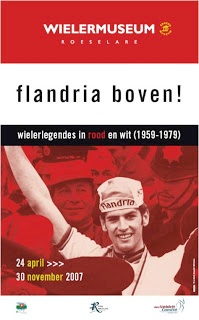Belgisk professionell tävlingscykel.

Flandria 1973


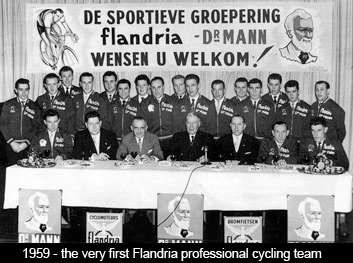
The team was formed in 1959, after a chance meeting in a Belgian café on a sunny Sunday morning, between Aimé Claeys, the owner of the Flandria bicycle company, and the young sprinter Leon Vandaele. Vandaele was a rider on the Faema-Guerra team, whose leader was the Belgian champion Rik Van Looy. Van Looy, known as “The Emperor”, held a tight grip on his team and all the other riders were expected to ride selflessly for him and sacrifice their own ambitions – or leave the team. In 1958 Vandaele had disobeyed orders and won both Paris-Roubaix and the Championship of Flanders. Predictably, after the inevitable conflict with Van Looy, Vandaele found himself looking for a new team. On hearing this, Aimé told Vandaele that he was willing to help and would be prepared to form a new team around him. The legendary “Iron Briek” Schotte was enlisted as rider-manager.
Aimé Claeys’ faith was immediately rewarded when the new Dr. Mann-Flandria team won 44 races in their debut season in 1959. Vandaele took 8 victories, including Gent-Wevelgem, and he was 3rd in Milan-San Remo.
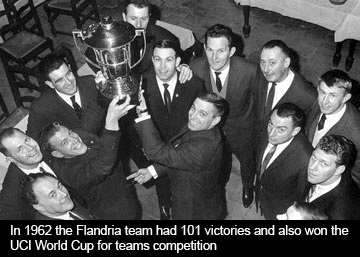
In 1962 reigning World Champion Rik Van Looy joined the team that he, unknowingly, had had a part in creating four years earlier. Van Looy was at the peak of his powers in 1962, and won the Tour of Flanders, Gent Wevelgem and Paris-Roubaix. Van Looy was the overwhelming favourite for the 1962 Tour de France but was denied victory when a collision with a press motorbike forced him to abandon. Said a rival racer: "Whoever wins now, his victory won't be complete. He won't have beaten Van Looy." Jacques Anquetil went on to win that year. 1962 also saw the introduction of a revolutionary new tactic by the Flandria team. At the end of a race the Flandria “Red Guard” would pilot Van Looy to within 200m of the finish, allowing him to comfortably out-sprint everyone else. The now ubiquitous “lead-out train” had been invented. Double Tour de France winner Gino Bartali believed that such tactics were morally reprehensible, and entirely against the spirit of cycling. Today, however, lead-out trains are the norm for any team possessing a strong sprinter. Flandria’s lead-out was awe-inspiring; the 1962 squad was so strong that many of the domestiques were themselves fast enough to win races, if they had not been ordered to sacrifice themselves for Van Looy. After Van Looy's departure from the 1962 Tour de France, Jozef Planckaert held the race leader's yellow jersey for seven consecutive days, before surrendering it in the time trial to Anquetil just two days before the finish in Paris.
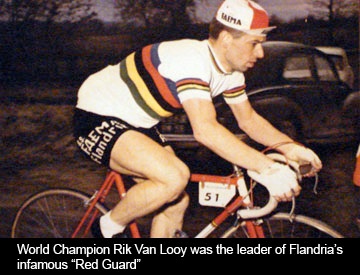
Van Looy’s stint at Flandria lasted only one year. In 1962 Flandria was still the secondary sponsor, with Italian firm Faema being the team’s title sponsor. The following year, the Flandria company began to invest more heavily in professional cycling and took over the lead sponsors’ role from Faema. This meant that the riders’ wages were now managed from Belgium rather than Italy. Van Looy, despite being Belgian himself, was not happy at this development, and for some reason insisted that he ride for an Italian sponsor. He left the team at the end of 1962, taking most of his devoted Red Guard with him.
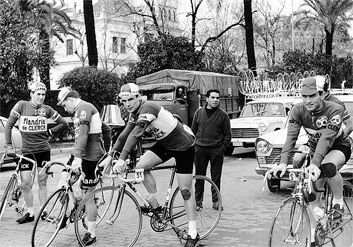
1962 had been a stellar year for the team, having won 101 races, but after the departure of Van Looy and his key lieutenants, the team needed to be rebuilt. Now under Flemish control, the team decided that a different approach was needed. Unlike all the other teams, Flandria decided that the squad would no longer be built around a single team leader. Strength in depth was more considered more important and the team became known for encouraging and nurturing new talent, and instilling in the riders that it was the success of the team, rather than individual success that mattered. This was to be achieved through the characteristically Flemish virtues of hard work, tenacity and mental toughness. Aspiring young Belgian cyclists dreamed of joining the Flandria squad, and when they were lucky enough to get signed, they felt they had no alternative but to produce results that would honor the Flandria tradition.
Walter Godefroot, soon to be known as “The Bulldog of Flanders”, joined the team in 1967. Already a professional for two years, he was neither flashy nor stylish. His riding style was aggressive and relentless, and he was the embodiment of the new Flandria philosophy. Eric Leman signed as professional with Flandria in 1968. He won Kuurne-Brussels-Kuurne in his debut season, and took the Tour of Flanders two years later in 1970, the first of his three wins in the race. Godefroot was also storming though the Classics in 1968, winning both The Tour of Flanders and Gent-Wevelgem, and took second in Liege-Bastogne-Liege and third in Paris-Roubaix. In 1969 he took the top step of the podium in the famous Roubaix velodrome.
The reputation of the hard-as-nails Flandria team continued to grow, and by 1970 they had become the number-one team to beat in the one-day Classics.
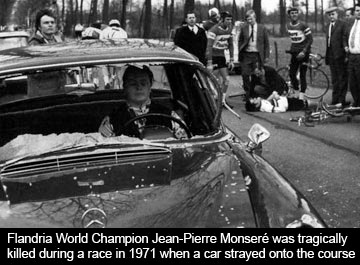
Roger de Vlaeminck started his career in 1969 with Flandria. Over the next 3 years he would learn the skills that would later take him to multiple classics victories and earn him the title "Mr Paris-Roubaix”. Another new pro joined de Vlaeminck at Flandria in 1969: Jean-Pierre Monseré was a prodigy who won the Tour of Lombardy that year, and in 1970 claimed Flandria's first professional world road championship title, when he was just 21. The following year, however, tragedy struck; Monseré was killed during a race whilst wearing the rainbow jersey of the world champion.
Despite the cruel blow of Monseré’s death, the new decade saw Flandria embark on its most successful period. Unlike the teams of today, who generally specialize in either the one-day classics or the multi-day stage races, Flandria targeted them all. The team had already won several stages in the three-week Grand Tours, and Jozef Plankaert had finished second overall in the Tour de France in 1962. Flandria’s next serious Tour de France contender was the Dutchman Joop Zoetemelk, who turned pro with Flandria in 1970. He showed great potential from the beginning, and in his first Tour de France Zoetemelk finished second, a feat he repeated in 1971.
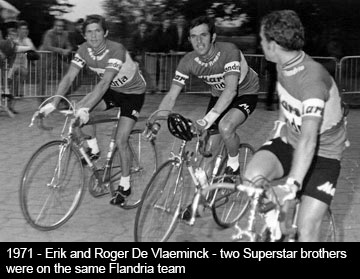
While Flandria was becoming a major force in the Grand Tours, the team continued to excel in the classics. In 1970 Roger De Vlaeminck won Liege-Bastogne-Liege and Kuurne-Brussels-Kuurne, and was second in Paris-Roubaix. Eric Leman took the Tour of Flanders, was third Milan-San Remo and was third in Paris-Roubaix, just behind De Vlaeminck. The following year, Flandria took the Tour of Flanders again, this time with Evert Dolman the victor. By 1971, Flandria had won 5 of the 13 Tours of Flanders it had contested.
1972 and 1973 saw three new signings by Flandria, a trio nicknamed “The Three Musketeers”. The first of these, Marc Demeyer, went on to win Paris-Roubaix in 1976. Flandria’s next addition was to become one of the greatest cyclists of all time. Freddy Maertens, a fresh-faced 20-year-old pulled on the hallowed red jersey and joined the professional ranks in 1972. Michel Pollentier, the third Musketeer, joined the Flandria School of Excellence a year later in 1973.
Demeyer’s victory in Paris-Roubaix is brilliantly documented in the cult film “A Sunday in Hell”, universally acknowledged as the best film ever made about professional cycling. It eloquently captures the atmosphere the drama of the Spring Classics. The Flandria team features heavily, and the gritty determination of the Flandria riders - particularly Maertens and Demeyer - is plain to see.

The 1970s saw Flandria innovate in other ways. In 1970, the Mars chocolate company were planning to launch the "Mars Bar" in Belgium and wanted maximum exposure for their product. They decided they could do no better than to associate it with the most high profile and most successful Belgian cycling team. A deal was struck, and Mars were brought in as co-sponsors of the Flandria team. As it had done with the invention of the lead-out train, and the creation of the first all-round powerhouse team, Flandria had again revolutionized professional cycling, participating in a high-visibility launch of a flagship product by a global corporate giant.
In 1973, Flandria initiated another major development. The Japanese component manufacturer Shimano was eager to enter the European market but had made little headway. Bicycle components were mostly supplied by Italian and French manufacturers, and the thought of a Japanese manufacturer equipping professional bikes was considered laughable. Flandria, however, had acquired a reputation as a progressive and open team, willing to try new ideas, and they struck a deal with Shimano. In return for feedback and suggestions for improvement from the riders, the Japanese company would develop a brand new line of components specifically for the Flandria team: the Dura-Ace range. The Flandria-Shimano team was born. This was the first time that an Asian manufacturer’s components had been seen in the European races, and the association with Flandria saw the prestige of Shimano soar.

Shimano did not have to wait long for Flandria to deliver a victory for Dura-Ace, as Walter Godefroot won a stage of the Ruta del Sol in February 1973. Flandria gave Shimano more great results that year, including 3 stage victories in the Tour de France, and Freddy Maertens’ second place in the infamous 1973 World Championship in Barcelona.
The day before the Barcelona World Championship, the Belgian team was out on a training ride when a car pulled up beside Maertens and Godefroot. In the car was Tullio Campagnolo, the head of the Italian component manufacturer Campagnolo – the number-one brand in Europe. Campagnolo asked Godefroot who was going to win the race. Godefroot pointed to Maertens and said “this one”, to which Campagnolo replied, “Oh God, not him. He rides with Shimano parts. At all costs Shimano must not win on Sunday”. On the day of the race, a group of four riders escaped close to the finish: the Spaniard Luis Ocana, the Italian Felice Gimondi, and two Belgians, superstar Eddy Merckx and the 21-year-old Maertens. In such a situation a Belgian win was the most likely, and the young Maertens had pledged to help superstar Merckx win the sprint if the opportunity arose. Merckx asked Maertens to lead out the sprint for him, but as the line approached, it was Gimondi, not Merckx, who came past Maertens for the win. Merckx, surprisingly, was several bike lengths back in fourth position. Merckx claimed that he had run out of energy and could not follow Maertens’ lead-out, which for Maertens was a bitter pill to swallow, given that Maertens could have won comfortably by himself, had he known that Merckx was in no condition to contest the sprint. Speculation arose that Merckx had deliberately concealed his exhaustion from Maertens, in order to prevent Maertens from going for the win himself. Had Merckx, out of loyalty to his own component supplier, Campagnolo, intentionally denied victory to Maertens, the only rider using Shimano components? Whatever the truth of the matter, this incident caused a bitter 30-year rift between the two champions, played out in detail in the Belgian press.

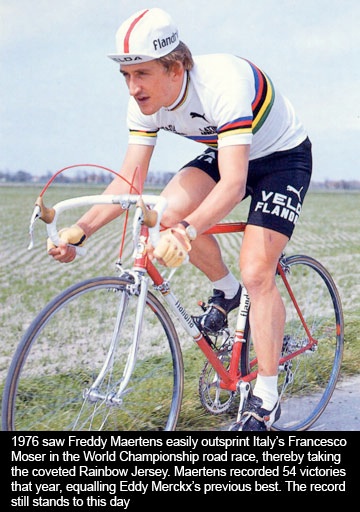
Freddy Maertens’ name is inseparable from the Flandria legend. Maertens stayed at Flandria for most of his career, during which time he became the greatest winning machine cycling has ever seen. He was at his peak in 1976 where he won Flandria’s second professional road race title, and he also took a record-equalling 8 stages of the Tour de France, which also gave him the Green points jersey. Maertens wore the leader’s Yellow jersey for half of the 1976 Tour. His tally of victories in 1976 was an astonishing 54, the most victories ever by a professional in a single season, tied with Eddy Merckx’s 1971 total.
Pollentier also continued to develop, and when he, Maertens and Demeyer were at their best in 1977, winning became almost routine. Flandria bikes racked up their greatest haul of victories in a single season - 103. 1977 was notable for another reason. Flandria offered a pro contract to the young Irishman Sean Kelly, who began an apprenticeship under Freddy Maertens, which was effectively a kind of sprinting masterclass.
In the 1977 Tour of Spain the Flandria team obliterated the opposition. Maertens won the prologue and led from start to finish, winning an unprecedented 13 stages, the overall classification and the points jersey. 14 out of the 20 stages were won by Flandria, with Pollentier taking the other stage win.
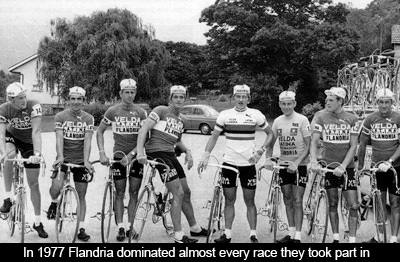
As the red tidal wave swept into Italy for the Giro d’Italia, Flandria’s dominance continued. Once again Maertens won the prologue and took the leader’s pink jersey, which Flandria defended until stage 5 when it was taken by the Italian Francesco Moser. By the time the race sped into Mugello, Maertens had already won 7 stages, was expected to take win number 8 and regain the pink jersey in the following day’s time trial, where he was the favourite to win. The run-in began as usual, with Pollentier taking the lead and Demeyer right behind, ready to take Maertens into the final kilometre, where he would power past for the win. However, in the sprint, Maertens was elbowed and crashed horrifically. Unconscious and bleeding, he was rushed to hospital where his wounds were stitched and his broken wrist was put in a cast. The following morning he was in so much pain that he was unable to start the day’s stage. Such was the solidarity of the Flandria team that the whole squad voted to quit the race and go home to Belgium. Maertens managed to convince them, however, that they should continue in his absence. Now on a crusade, the team’s determination was even greater. Demeyer won two more stages and Pollentier outclimbed Moser in the Dolomites, taking back the leader’s jersey and holding on to it until the end of the race to claim the overall victory.
By now, Flandria had won every race on the calendar except for Milan-San Remo and the Tour de France, and in 1978 that elusive Tour win became their number-one focus. Maertens was not a good enough climber to be a yellow jersey candidate, so the team’s overall strategy depended on Pollentier performing well in the mountains. Pollentier had shown he was in-form having just won the Dauphiné Liberé. If Pollentier could take the yellow jersey in the Tour, Maertens the Green points jersey, and Demeyer stage victories, Flandria would make an indelible mark on the Tour’s history books.
Initially, the plan worked to perfection. Maertens won two early stages and had a firm grip on the green jersey, Pollentier had the climbers’ polka dot jersey, and even Sean Kelly had won a stage in what was his first Tour de France. On the crucial stage to Alpe d’Huez, Pollentier broke clear of the pack and soloed to victory on the murderous ascent, increasing his advantage over his rivals and claiming the yellow jersey. Flandria now owned all three principle jerseys in the Tour: yellow, green and polka dot, and it seemed that they would surely hold onto them until Paris, which was now only 6 days away.
What subsequently transpired, however, did not go according to plan. Pollentier, exhausted and suffering from extreme dehydration after the climb to Alpe d’Huez, was unable to provide a urine sample at the doping control. Failure to provide a sample is treated as equivalent to a positive drugs test and Pollentier was controversially excluded from the race. Maertens, however, retained his green points jersey all the way to the Champs Elyseés and Demeyer took a further stage victory, while the Portuguese rider Joaquim Agostinho ensured Flandria still made the podium in Paris, taking third overall.
Flandria’s final season in 1979 saw the team again miss out on overall victory in the Tour de France, with Joaquim Agostinho again taking third.
During the 20 years of their existence, the Flandria team and Flandria bicycles were the dominant force in professional cycling. While other teams were able to field a single star rider for short periods, no other team has had such a diverse array of champions as Flandria, and no other team gave so many future champions their break in professional cycling. All of the big names of Belgian cycling wore the famous Flandria colours at some point in their careers; the only exception was Eddy Merckx, who did not fit with the Flandria ethos of refusing to build a team around a single rider. Flandria were always the team to beat in the Classics, completely steamrollering the opposition. They amassed an utterly staggering 70 (seventy) Classics victories. No other team in history was so consistently excellent as Flandria, in both the Grand Tours and the Classics.
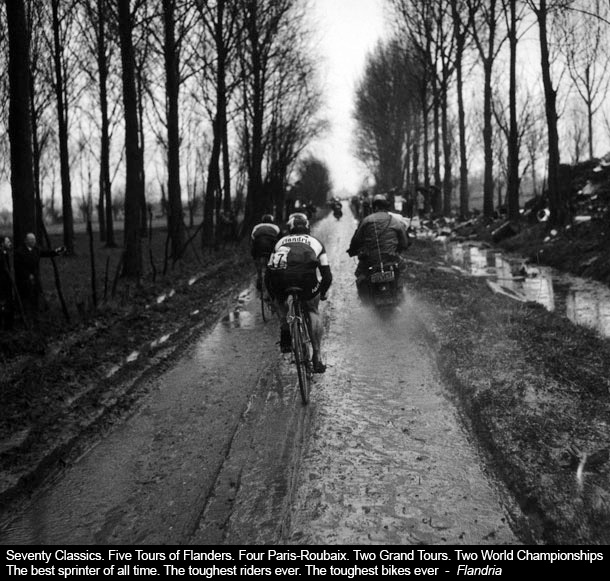
My favourite has to be my Flandria bike, built about 1972 by the Flandria bike company in Belgium. I introduced Flandria bikes into Ireland, after reading an article on the bikes in a magazine which prompted a phone call which in turn led to an invitation to visit the factory in Zedelgem near Brugges, in the early 70s I was in the cycle trade. In the factory at Zedelgem I was given a tour of the shop floor where the frames and bikes were made, followed by an inspection of their showroom where lines of racing models were on view, some were equiped with Campagnolo, others all Shimano. Flandria made a complete range of cycles, from kiddies bikes to the replica team racers. They were a giant company, with factories in Germany,France and Portugal as well as Belgium, engaged also in the manufacture of mopeds and m/cycles, gas heaters and fires.
The bike I own is the team replica ridden by many top professional stars such as Freddy Maertens, Roger De Vlaeminck, Rik Van Looy, Joop Zoetemelk and our own Sean Kelly. It was Flandria that signed up Kelly for his first pro contract
Pol Claeys was the fourth generation of his family that directed the Flandria company in Zedelgem, West Flanders. The company expanded from bicycles to produce mopeds and small motorbikes. Upon bankruptcy in 1979 precipitated by the rapid decline of the moped division, the Flandria company ceased operations. The team was disbanded, and the riders found new sponsors.
Flandria
Flandria var en Belgisk cykeltillverkare lokaliserad i Zedelgem inte långt från Brygge. Cykeltillverkningen startade efter första världskriget av Louis Claeys. Företaget växte snabbt och man startade produktion även i Frankrike och Tyskland. På 60-talet började man också producera motordrivna fordon, mest då mopeder men även mindre motorcyklar och även trädgårdsredskap så som motordrivna gräsklippare. Tyvärr tog det hela slut 1979 då företaget tvingades i konkurs.
Tävlingsverksamheten startade 1959 när man bildade ett eget cykellag. Detta fortgick mycket framgångsrikt ända fram till konkursen 1979. Under de 20 åren som tävlandet pågick var man utan tvekan ett av de mest framgångsrika teamen i världen och många av Belgiens största stjärnor har tävlat för Flandria.
Här nedan följer två artiklar som beskriver Flandrias storhet.
Min Flandria cykel, ”En katt bland hermelinerna”
Min ram är utan tvekan en Team replica bygd i Ishiwata 022 rör och med Shimano gaffeländar. Den är gjord någon gång i början av 70-talet och jag har bestämt mig för att det är en 73:a. Detta för att säsongen 1973 använde Flandria, som första professionella stall, Japanska komponenter på sina cyklar, nämligen Shimano. Man gjorde en överenskommelse med Shimano om att ge feedback på utrustningen, i gengäld tillverkade Shimano en helt ny grupp till stallet som fick namnet Dura Ace. Jag har en Dura Ace grupp 7100 liggande som kommer att bli perfekt till den här cykeln. Det innebär att Ramen är gjord av Japanska Ishiwata rör, gaffeländar och komponentgrupp är Japansk Shimano. Detta blir ett bra komplement till mina övriga 70-tals cyklar där jag tidigare inte haft någon Japansk representation.
FLANDRIA, vilket bidrar till att företaget sedan Alexandre CLAEYS, som 1825 gift med dottern Dombrecht Zedelgen vars far ägde en smedja. År 1896, Louis Claeys, född 1846, son till Alexander, byggd med sin son Leon den första cykeln med märket av Lejonet av Västflandern. Det är efter första världskriget som alla Claeys son grundade sin egen firma: de Claeys Mills Brothers blev Flandria. Den sista av Aimé Claeys, dog 1979, är det hans son Pol och hans fyra söner i lagstiftning som tjänar det arbete som påbörjats över hundra år tidigare. År 1959, framgår att Flandria i tävlingar. År 1960, företagets s "associerar Wiels. Flandria 1963 inkluderar: Guillaume Driessens är athletic direktören. Den suivanteil år tar som vice Brick Schotte. År 1965 är den grupp som kallas: Flandria-Romeo; efter två år Driessens s "löv, Flandria s" associerar De Clerck. Vi befinner oss i 1967, är sportchef Scotte och jersey är röd och vit. Denna grupp kommer att existera fram till 1969, då Schotte tar som vice Noël förgrunden. År 1970, ny grupp med Flandria Mars föreningen. Även sport management och även jersey. År 1971 Schotte är ensam. Mars avgick från konkurrens och det är Beaulieu som tar över. År 1973 har koncernen två nationaliteter, belgiska och franska; det kallas Flandria-Shimano-Carpentier. Pierre Molineris blir vice Schotte. 1974, nytt namn: Flandria-Shimano-Claes-Merlin Beach. Denna grupp är franska och sportchef är J.Cadiou. Tröjan är röd med vita ränder. Men det varar bara att ett år. År 1975, Belgien Flandria återupptar sitt medlemskap, och påminner Scotte s "associerar Carpenter-Confortfluxe. År 1976 åter Driessens, med Schotte som leder den belgiska koncernen Flandria-Velda. Schotte blev suppleant. Tröjan är röd vit rand.
Monday, February 1, 2010
Why Flandria is the greatest cycling team ever
The greatest cycling team ever? You'll get a lot of debate over that one. Every era has its usual suspects.
The 60's? St. Raphael (Anquetil/ Stablinski/ Darrigade/ Saint/ Riviere/Elliott)? Peugeot (Simpson/Merckx/Pingeon/Bracke)? Salvarani (Gimondi/Adorni/Altig)?
70's? How 'bout Molteni (Eddy Merckx/Bruyere/Swerts)? Mercier (Poulidor)? Kas? Bianchi?
The 80's? The Dutch TI Raleigh squad (Raas, Knetemann, Zoetemelk)? Renault-Gitane(Hinault/Fignon/LeMond/ Madiot)? Or maybe LaVie Claire (Hinault/ Lemond/Bauer)?
90's? Had to be Mapei (Rominger/Museeuw/Tafi/VDB/Ballerini) or was it Miguel Indurain's Banesto? The past decade that saw Lance's Postal juggernaut morph into Discovery and then Astana? Or CSC/Saxo Bank?
Well, I submit there's one team that rises above all on a number of criteria. Flandria.
For 20 years - from 1959 until it's namesake patron bicycle manufacturer went bankrupt in 1979 - Flandria was to Belgian cycling as the Steelers were to Pittsburgh football. The reference, the summit. End of discussion.
First there's the roster. The legends who rode for the "Red-Guard" reads like a laundry list of cycling's greatest. No other team ever featured so many different champions, over such a long period. It started with Joseph Planckaert. Then came 'the Emperor' Rik Van Looy - the first man to win all the classics. His mates Ward Sels and Noel Fore. Dutch six day star Peter Post. Walter Godefroot, the bulldog of Flanders. The first Dutch Tour winner Jan Janssen rode in red for awhile near the end of his career. As did Herman Van Springel, loser of a heartbreaker '68 Tour to Janssen, consoled as king of the now-defunct motorpaced classic marathon Bordeaux-Paris. Cyclocross and classics stars brothers Erik and Roger DeVlaeminck. A neo-pro named Joop Zoetemelk. 3 time 'Ronde' winner Eric Leman got his start there too.
Then there was Jempi Monsere - the James Dean of Belgian cycling. Jempi was a prodigy who was 1970 world road champion in Leicester England and was tragically killed the next spring in a crash against a car driven the wrong way onto a kermesse course in Retie.
There were Flemish hardmen like Andre Dierckx and Johan DeMuynck. Cyrille Guimard - the French sprinter with bad knees who became a 'champion maker' by directing Lucien van Impe to a Tour de France win, and then discovering Hinault, Fignon, and some American teen named LeMond. Flandria even put Portugal's Joachim Agostinho on the Tour de France podium twice in his late 30's.
Most famous of all, the team birthed the career of Freddy Maertens who was virtually unbeatable in a sprint and won almost everything during his peak years. His supporting cast were no slouches either. Michel Pollentier stepped up to win a Giro D'Italia in '77 after leader Maertens crashed out. Marc DeMeyer similarly won Paris Roubaix, a ride made famous in the famous Jorgen Leth documentary 'A Sunday in Hell'.
Close to my own heart, a young Irish pro named Sean Kelly got his start at Flandria - a team where there was none of the chavinistic or nationalistic prejudice you'd see in the French, Italian or Dutch teams. If you could work, suffer, perform and still laugh, in the Red Guard, you were accepted for who you were, not where you were from.
Need more proof? Well there's the breath of race-types they were competitive in. Flandria didn't specialize in classics or tours like most teams today. It raced 'em all - across the board, and played a lead role in any race they took on. They had three world road race champions. Classics by the boatload, year after year. Giro? Vuelta? Check. Paris-Nice? Bien sur. Roubaix? Oui, monsieur. In total, Flandria at some point won every race except the Tour De France, and I still say Pollentier would have taken it in '78 if he hadn't been caught tried to cheat dope control at Alpe d'Huez with a bulb of somebody else's urine under his arm. His mate Maertens had won 8 stages and the green points jersey in '76 and was maillot jaune for half that race. Yes, even at the Tour, Flandria was a force. Some say the organizers only threw Pollentier out because he was Belgian and the French were sick of those damn Belgians winning their Tour.
Then there's the leader. Any team directed by 'Iron Briek' Schotte - the last of the Flandriens - deserves to stand at the summit in my book. Training in the sun of the Riveria? Screw that. Why bother when you can train 'a-la-flahute'. 200k in January, to the north sea and back. Wind, rain, snow and cobbles? Makes you sterk (strong). A raw egg in stout for breakfast. Steak and a beer in your musette. Back for vegetable soup and early bed and get up and do it all again the next day.
Guillaume Driessens also had a tilt at the helm. Look up 'rogue' in the dictionary and there's a picture of Driessens. Big, verbal, manipulative and charismatic. Eddy Merckx hated him, thought he was a phony. So did the wives of most of his riders because he'd barge into their kitchens unannounced and try to teach them how to make minestrone. Yet he motivated and willed Freddy Maertens into a one of the greatest winning machines cycling has ever seen.
Finally, there's the tradition of consistency. Flandria was a west-vlaanderen institution: An artisinal bicycle factory owned by the hard working Claeys family that grew to a multi-location industry that expanded to mopeds, lawnmowers and even small motorbikes. Flandria mostly served the french and belgian domestic markets, and kept the pro team together by cobbling together a budget from a constantly-changing succession of extra-sportif sponsors, and by being 'cheap-prick' flemish about keeping rider salaries and other spending as low as possible.
As a result, competition within the team was sometimes tougher than that faced with the opposition. At Flandria, riders felt honored - obligated even - to uphold a tradition. Fame and glory in the community was not an insignficant substitute for the meagre diret financial reward. Because Flandria riders had to graft, hustle and angle for cash to supplement their salary the team had a strong flemish culture of hard work for it's own sake. As a sports team, Flandria was neither flashy nor stylish. Just consistently excellent.
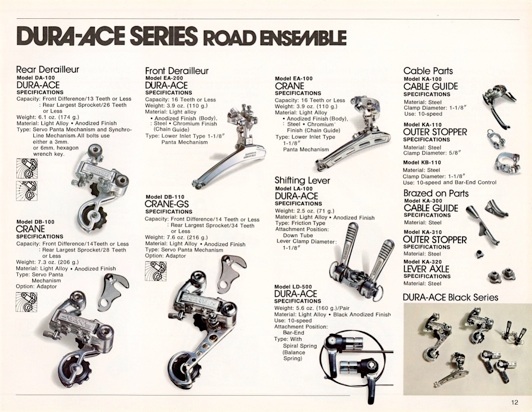

Flandria, av Fast Eddy's Flandria Cafe
Flandria, från http://www.flandriabikes.com/history
